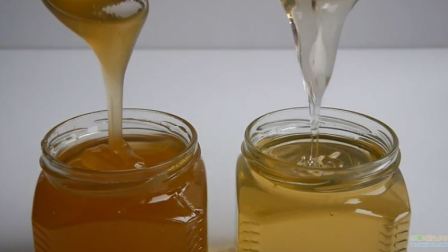How to distinguish natural acacia honey from a fake by appearance

Acacia honey is one of the most expensive types of honey in retail. For this reason, acacia honey quite often becomes an object of counterfeiting.
When purchasing acacia honey, pay attention to the color and aroma, as well as the taste of the honey. Pure acacia honey has white acacia honey that is as clear as water, has virtually no aroma and a simple sweet taste.
If the honey is cloudy, has a pungent odor of white acacia flowers, causes soreness or bitterness, this is a reason to think about it. At best, it’s just mixed flower honey mixed with white acacia honey. You should also pay attention to the consistency of acacia honey; real mature acacia honey from white acacia is liquid, but very viscous. Therefore, if honey flows from a spoon like water, the thin stream is interrupted, there is no characteristic pyramid, the last drops are not spring-loaded, then this is definitely a reason to think about it. Perhaps the honey is simply immature, this happens if the beekeeper pumps out the honey too early, especially if it rains during the acacia flowering period, or the bees were fed sugar syrup. But such honey cannot be called high-quality and no real beekeeper would sell it to the market, undermining his reputation. At worst, it's just sweet syrup.
White acacia honey should remain liquid even in December, so shriveled honey is also a reason to think about it.
How to distinguish acacia honey from a fake using improvised means
How to determine naturalness of acacia honey? How to check acacia honey on the market? If you are faced with the question of how to distinguish acacia honey from a fake, pay attention to what acacia honey looks like. The consistency, aroma, taste, and color of acacia honey should correspond to honey from white acacia flowers. If you are offered honey that has a different type, then at best you are offered acacia flower honey. If natural acacia flower honey is not a big problem, but the honey that you are offered is still not honey from white acacia flowers, at least it should cost much less than pure white acacia honey.
If the honey looks like real honey, then the next step is to determine whether the honey is natural acacia or not. The easiest way to see how honey flows is that it should not be very liquid like water and flow down in a characteristic pyramid. Even a thin stream of flowing honey does not break. Natural acacia honey, when you drip it, the last drops are pulled up; when a drop falls into the honey, it does not create splashes.
Of course, you can check honey on the market, how to distinguish acacia honey from a fake - drip it on paper, using a pencil, dilute honey in a glass, but only the methods of falsifying honey that existed in the last century are gradually disappearing. High-quality fakes come to the fore, which can be identified by a laboratory, but not just any one. It is difficult for a laboratory to distinguish a high-quality fake even of an average quality.
Therefore, if you want to buy good, natural acacia honey, find a beekeeper who values his name, who has a nomadic apiary or an acacia forest next to his apiary and buy honey directly from him. Nowadays, delivery is common; honey will be delivered quickly straight to your home. Remember, white acacia thickets are mainly located in the south, so white acacia honey can only be found in apiaries in the southern regions.
Acacia honey or flower honey
It is not always possible to obtain pure acacia honey, firstly because the weather is not always favorable for obtaining acacia honey from white acacia; sometimes rapeseed or other honey plants bloom at the same time as acacia. In this case, prefabricated flower honey is obtained. Acacia honey with an admixture of rapeseed settles very quickly and beekeepers absolutely do not like this mixture. It’s another matter when honey locust nectar is added to the acacia method, in this case acacia honey acquires an interesting golden color, as well as a wonderful aroma. Sometimes bees mix linden nectar with acacia nectar, resulting in linden acacia honey.
People often ask which honey is better: linden or acacia? It should be noted that these types of honey are simply different; each of these varieties, acacia honey or linden honey, has its own characteristics and areas of application. Acacia honey is great for children, acacia honey is good for the eyes, for many other people, while linden honey is good for treating colds and many other cases. The main thing is that the honey is natural.
